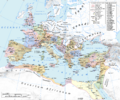Roman province facts for kids
In Ancient Rome, a province (called provincia in Latin) was a very important part of how the Roman Empire was organized. It was a large area of land that Rome controlled outside of Italy. Think of it like a big region or state that was part of the Roman Empire. The word province we use today comes from this old Roman word.
Contents
What Was a Roman Province?
The Empire's Building Blocks
A Roman province was a major area of land that the Roman Empire ruled. These areas were outside of the peninsula of Italy, which was the heart of the empire. Provinces were the biggest way the Romans divided and managed their vast lands.
How Provinces Were Governed
Each province had a Roman governor in charge. This governor was usually a powerful Roman official or a former high-ranking politician. Their job was to keep order, collect taxes, and make sure Roman laws were followed. They also commanded the Roman soldiers stationed in the province.
Why Provinces Were Important
Provinces were key to the Roman Empire's success. They provided resources like food, metals, and other goods. They also helped Rome expand its power and influence across many different lands and peoples.
History of Roman Provinces
Early Provinces
The first Roman provinces were created as Rome conquered new territories. For example, Sicily became Rome's first province after the First Punic War around 241 BC. As Rome grew, so did the number of its provinces.
Provinces Under the Republic
During the Roman Republic, provinces were often managed by former consuls or praetors. These officials were chosen for one year to govern a province. Sometimes, this system led to problems, as some governors became very rich or powerful.
Provinces Under the Empire
When the Roman Empire began under Augustus, the system of provinces changed. Some provinces were directly controlled by the emperor. Others were still managed by the Roman Senate. This new system aimed to make the empire more stable and efficient.
New Divisions by Diocletian
Around 300 AD, Emperor Diocletian made big changes to the provinces. He divided the larger provinces into smaller ones. This was done to make the empire easier to manage and defend. He also grouped these smaller provinces into larger units called dioceses.
Life in a Roman Province
Roman Influence
When an area became a Roman province, it slowly adopted Roman ways. People started using Roman money, laws, and sometimes even the Latin language. Roman roads, buildings, and cities were built, connecting the provinces to Rome.
Local Customs and Taxes
While Roman culture spread, local customs often remained. People in the provinces usually paid taxes to Rome, often in the form of goods or money. These taxes helped fund the Roman army and the empire's projects.
Images for kids
-
Roman Empire under Augustus (31 BC – AD 14). Yellow: 31BC. dark green 31–19 BC, light green 19–9 BC, pale green 9–6 BC. mauve: client states
-
The Roman empire under Hadrian (125) showing the provinces as then organised
-
The new territorial division of tetrarchic system, promoted by Diocletian (around 300 AD).
See also
 In Spanish: Administración provincial romana para niños
In Spanish: Administración provincial romana para niños





